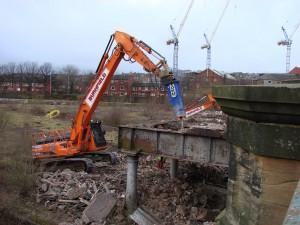
A few years ago I wrote about a fairly new parking garage that was being torn down in my neighborhood to make way for the expansion of a hospital. Several other examples came to light over the preceding years. There’s the story in New York about the Modern Museum of Art considering demolishing a fairly recent structure that housed a museum next door because it didn’t line up with their floor plan (among other reasons), and the old warehouse-to-post office-to-EPA building in Denver that saw three buildings constructed on the same plot of land in the same time as an original warehouse across the street was renovated to LEED standards. In the case of the post office, the land was degraded and required remediation as a result of asbestos contamination on the site.
I bring this up because demolition began today on a car dealership near my current home in the upper Midwest. The facility is located in an odd spot right next to, and under the shadow of, the highway. What looks to be a perfectly suitable structure from the exterior is being razed. This ephemeral approach to structures stands in opposition to the true aims of green building.
Taking the Cradle to Cradle concept into account, buildings need not only incorporate materials that can be repurposed upon the cessation of use, but buildings need to be designed from the start with their next iteration in mind. Companies in the midwest like RW Collins have years of experience with remediation, a key first step toward long term planning and sustainable building. Projects like the car dealership require special consideration in order to make the land habitable moving forward. By definition a plot of land next to the highway is marginal and fraught with potential contaminants. Curiously, as work progresses, there appears to be topsoil that has been added to the site. If the plan is for some sort of planting to occur, this makes the need for remediation that much more important.
Being intentional about how to treat these sites is essential. After all, not all brownfield sites can turn into solar farms.
[Image source]




